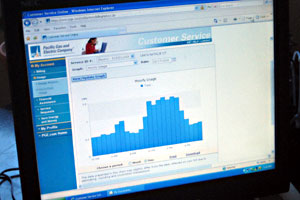 Hourly energy use data, now online.
Hourly energy use data, now online.
I've never paid much attention to my electric meter. For most of us, it's just that box on the side of the house with a small white disk spinning inside, keeping track of our energy use. But over the next three years, all the meters of PG&E customers will be getting a major upgrade to a new, digital SmartMeter.
I met one customer, Ken Kube in Castro Valley, whose meter has already been upgraded. Since the new meters track his home energy use digitally, Kube can log into his PG&E account and see his real-time energy use. On one level, it's really the ultimate tool for parents who like to remind their kids to turn out the lights. But it's also a powerful conservation tool. Kube could see how much energy he uses at night, when his appliances are drawing power in stand-by more (what's known as "vampire" power).
These meters are just a small piece of the puzzle when it comes to a smart grid. Just what the smart grid is depends on whom you ask, but most people agree it comes down to one thing: communication. The energy landscape is changing rapidly. In addition to increasing demand, there's more renewable power like large-scale solar and wind coming online - which are often far from urban areas and are available intermittently. There's also small-scale solar on building rooftops - which means energy consumers are becoming energy producers. There will also be plug-in electric cars, which need to draw power from grid.
To manage all this, utilities and grid operators need more information than they have. And that's where meters come in. But as Kurt Yeager of the Galvin Electricity Initiative describes, it's a huge networking challenge - and a huge market opportunity.
